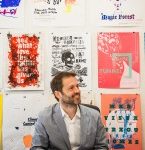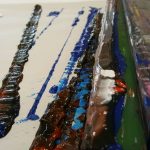By Jenny Park ‘22
“Mark, I need some help.”
 My 2D Design professor, Mark Allen, is a character—his funny and quirky demeanor puts anyone at ease. I had wanted to create some prints for a personal project, so naturally he was the first person I went to. We went down to the screen-printing lab and got to work.
My 2D Design professor, Mark Allen, is a character—his funny and quirky demeanor puts anyone at ease. I had wanted to create some prints for a personal project, so naturally he was the first person I went to. We went down to the screen-printing lab and got to work.
Screen-printing is a process where you squeegee ink onto a surface, usually a thick sheet of poster paper, through a fine mesh screen to create an image. Much like how acrylic paints, watercolors, digital art, woodworking, and other mediums have their own unique feel and touch, screen-printing had an allure that I couldn’t help but explore. Unique to screen-printing, registration is necessary when a print needs two or more color components and you want the images to align perfectly.For example, if I wanted an image of a grapevine, with one screen as the vine with green ink and another screen as the grapes with purple ink, I would want the grapes and the vine to look like a cohesive picture.
 Having never done any silkscreen printing before, I tried my best to not miss a step so that Mark wouldn’t have to repeat himself. I took pictures at every step of the process: taking in first the design in Adobe Illustrator, printing the film, transferring the design to the frame, washing off the excess emulsion, fixing the frame to the board, squeegeeing the ink onto the surface, then putting the print on the rack and the frame out to dry. It seemed complicated and daunting at first, but the more I did it the more I got comfortable with the process. Picking out the inks and adjusting the registration started to feel intimate and familiar. I had fun with slightly offsetting the different components so that the alignment wouldn’t look as perfect; digital art already has a too-seamless kind of texture, so the mistakes helped to offset that. In addition to inks, I could also transfer on metallic textures and other materials.
Having never done any silkscreen printing before, I tried my best to not miss a step so that Mark wouldn’t have to repeat himself. I took pictures at every step of the process: taking in first the design in Adobe Illustrator, printing the film, transferring the design to the frame, washing off the excess emulsion, fixing the frame to the board, squeegeeing the ink onto the surface, then putting the print on the rack and the frame out to dry. It seemed complicated and daunting at first, but the more I did it the more I got comfortable with the process. Picking out the inks and adjusting the registration started to feel intimate and familiar. I had fun with slightly offsetting the different components so that the alignment wouldn’t look as perfect; digital art already has a too-seamless kind of texture, so the mistakes helped to offset that. In addition to inks, I could also transfer on metallic textures and other materials.
 It was only after I had finished that I felt the strain of standing for several hours at a time to work on prints; it was easy to forget about stretching and proper posture while engrossed in the middle of what was turning out to be a cool project. At times the lab would be bustling with activity, and at other times it would be completely empty, free for me to use. Sometimes I would bump into other art majors, busy with their own deadlines to manage. This is one thing I appreciate about the art department here at Pomona—I rarely, if ever, feel as if the space is too cramped for my own work. With resources like the photography lab, the screening-printing lab, the Gray Space (for exhibitions), and much more, I have everything I need.
It was only after I had finished that I felt the strain of standing for several hours at a time to work on prints; it was easy to forget about stretching and proper posture while engrossed in the middle of what was turning out to be a cool project. At times the lab would be bustling with activity, and at other times it would be completely empty, free for me to use. Sometimes I would bump into other art majors, busy with their own deadlines to manage. This is one thing I appreciate about the art department here at Pomona—I rarely, if ever, feel as if the space is too cramped for my own work. With resources like the photography lab, the screening-printing lab, the Gray Space (for exhibitions), and much more, I have everything I need.
I recently declared as an art major this semester, and I’m sure that, like many others, naming my major felt like an unsure step on unstable ground. Am I making a mistake? Is this a waste of time and resources? How employable does this make me? (Especially for art?) In spite of all these doubts and questions, I was reminded by friends and family (or maybe read somewhere on reddit—I can’t remember) that the deciding factor in my success will not be which major I picked or didn’t pick, but me—my skillsets, my habits, and my relationships with professors and friends. With that in mind, I hope to fill as many sketchbook pages, create as many paintings, photos, and prints, and get my hands as dirty as possible with the remaining time I have left here at Pomona.
